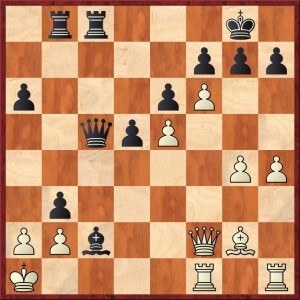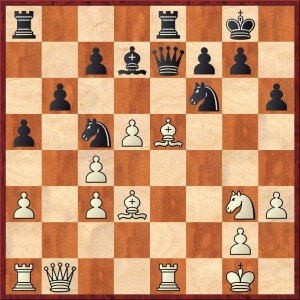
Having been a solid mainstay for the USCL throughout his many years of playing, it surprisingly took GM Benjamin until now to receive his first GOTW Award, but he managed to do so to kick off his seventh season. In a tense middlegame with both players very low on the clock, he eventually ground out GM Charbonneau in an ending and secured an important half point for his team to start the year.
1st Place: GM Joel Benjamin (NJ) vs GM Pascal Charbonneau (NY) 1-0

GM Benjamin strongly opened up the seeming lifeless position with 33. e5!, eventually getting the best of the resulting complications and saving a drawn match for his team
IM Salvijus Bercys (1st Place, 3 Points): This was not an easy week to start off with … and by that I mean I wish I could give all games no place in GOTW. This week the choice was “Which lackadaisical game deserves to win GOTW?” GM Benjamin clearly outclassed his opponent, and it was hard to see anything wrong with his play. 33. e5 blew the game wide open allowing White to consolidate his positional edge because even then Black continued to play super passive. Black’s play could be described as playing for a draw. There was no aggression in the opening (and later GM Benjamin didn’t allow any), no try to play for any advantage - just ok with a draw. Draw with Black in a team tournament is ok but everyone knows - when you play for a draw, you are rarely ever going to get it. Nice positional play by White and … well that’s it.
IM Victor Shen (1st Place, 3 Points): Things were looking pretty dry for a while until Joel’s manuevering scared Black into opening the Queenside with 29… a6? To me, this seemed very good for White, as he now had two fronts of attack. The exchange sac was also pretty cool (by the way, as a note for the readers, I will not be in my comments pretending I knew what was going on by posting a ton of computer lines. You can do that yourself). Perhaps one of you will even point out that the exchange sac was unsound (although I really doubt it). Oh well. This game, although unclear, was the most creative and exciting effort of the week.
FM Aleksandr Ostrovskiy (1st Place, 3 Points): When I first played through this game, it really appealed how to me how White slowly outplayed Black by expanding his position and then pushing his opponent around a bit until orchestrating a breakthrough and then taking the full point. White played the King’s Indian Attack, and Black defended with a development of 4… Bd6, a rare line that I believe is favored by GM Kengis. White seemed to get a plus out of the opening with a decent share of space but Black kept a fully playable position. White sounded the charge with 21. f4!? to which Black erected a barricade on the sixth rank as the acceptance of the b4 pawn could have led to unpleasantness following f5.
White enjoyed his extra space from maneuvering and decided to step forward with 33. e5 which had the idea of bringing the Knight into the fray with 34. Ne4. Unfortunately for bBlack, it seems that he missed his chance to overtake the initiative with 34… f5! which allows the scary looking 35. Nf6 but after the cool 35… Rd8 the aggressor turns into a prisoner inside Black’s camp. Naturally the computer instantly sees this possibility but in a practical game with the clock ticking and a tempting alternative to win an exchange, these moves are not simple to find. Despite being down an exchange, White’s advantage grew to decisive proportions after 40. Rxb6!, but amazingly Benjamin let black off the hook with 46. Qg7+? in what I could only presume was a situation influenced by the clock. Nevertheless Charbonneau did not manage to hold his inferior endgame, and White came out on top. An instructive game (despite the errors as it is of course chess!) in which Benjamin defeated his strong GM opponent.
Chess.com (1st Place, 3 Points): 50% of vote
FM Alex Barnett (3rd Place, 1 Point): I’m not a fan of this game. Seemed like a snoozefest until Black got overly ambitious on the Queenside and moved the Bishop away from b7 allowing the 33. e5 - 34. Ne4 idea, he should have just chilled. White’s attack pretty much played itself, and the technique to finish it off wasn’t that great. It was a crush but still not my favorite game.
Total score of Benjamin vs Charbonneau: 13 Points
———————————————————————————————————————————————————————————————————-
2nd Place: Nicky Korba (LA) vs Siddharth Banik (SF) 0-1

Banik nicely finished off the game with the aesthetically pleasing tactic 29… Qa3! to which there was no answer
FM Alex Barnett (1st Place, 3 Points): I picked this game because it was completely one-sided and pretty instructive on how to play the Najdorf. Direct and to the point, White never had a chance. 29… Qa3 at the end was extra sexy as well. This is how I want all my wins to be.
IM Salvijus Bercys (2nd Place, 2 Points): I was watching this game online, and I felt it’d be chosen but hoped it wouldn’t be. This game reminded me of the 19th century Paul Morphy or Adolf Anderssen games where their opponents would ignore threats and let them be mated in the most glamorous ways. Except this game was half ignore, half panic. White ignored Black until Black’s Knight reached c4 which was easily prevented by 16. b3 after which White’s monstrosity of a Bishop on d4 would forever thwart any mate threats. Once the Knight on c4 was established, Black’s attack was pretty straightforward, and White kept panicking with the Knight. Only reason this game is above third place is because Black’s final touch was pretty.
IM Victor Shen (2nd Place, 2 Points): I’m all for rewarding cool and interesting games even if they’re sloppy, but 29… Qa3!! is not enough for GOTW. In what should have been a race to attack the opposing King, White shuffled his pieces around until he got mated. Yes, it looks like Black played well but we always look our best against weak resistance, no? Still, I’ll give it second place instead of third because I’ve never sacked my Queen for mate.
Chess.com (2nd Place, 2 Points): 26% of vote
FM Aleksandr Ostrovskiy (3rd Place, 1 Point): This Board Four matchup between two youngsters began with the topical h3 Najdorf but soon took the contours of a French Defense. White’s setup looked quite intimidating but it seemed to be a bit tricky to come up with an effective method of attack while Black’s Queenside counterplay was very natural. In practice Black has done very well from this type of position (starting from move 12 where Black usually chooses the more common 12… b5 13. e5 d5), and this game was no exception. It seemed to me that White’s play was too slow; comparing the position on move 15 to the one on move 20, Black has mobilized his entire army while White merely shuffled a few of his troops around! With all his pieces aimed at White’s King, Black effectively broke through with 25… Na3+ and the coup de grace 29… Qa3! Overall a strong effort from Black, but White never really got into the game.
Total score of Korba vs Banik: 10 Points
———————————————————————————————————————————————————————————————————-
3rd Place: IM Irina Krush (NY) vs GM Boris Gulko (NJ) 1/2-1/2

With the strong Queen sacrifice 20… Qxe5!, GM Gulko got the favorable side of the position
FM Aleksandr Ostrovskiy (2nd Place, 2 Points): Gulko employed a slightly unusual set up with a delayed Nf6, but the game entered familiar territory soon enough. Actually the first nine moves of the game had already been known to Gulko as he had faced this position back in 2002! Krush deviated on move ten with 10. bxc3 and the position featured the typical struggle with White having two Bbishops, and Black having the better structure and some interesting outposts. Both sides utilized familiar plans with Black shuffling his Knight to c5, and White struggling to use the power of her Bishops by playing 16. f4 and then organizing e5.
After 18. Re1, it looked as if White was going to exploit Black’s lack of control over the e5 square and play the strong e5 herself, but Gulko responded with 18… h6! with (well I thought!) the idea of g5. However Black had other plans and essayed a positional Queen sacrifice with 19… dxe5!? and 20… Qxe5!, leaving him with excellent compensation for the Queen. I thought the outcome was balanced, and in the end White forced a perpetual in a position where otherwise she might have been on the back foot. An interesting game which was conducted well by both sides and fairly resulted in a split point.
FM Alex Barnett (2nd Place, 2 Points): I love Queen sacs for two pieces + counterplay. Black played directly and to the point throughout. It’s a shame he couldn’t convert but 20… Qxe5 deserves props because if he doesn’t have that move, he is much worse, but after Qxe5 he’s the one pushing for the win. Black was in control the whole game, and White was lucky to draw IMO. Qxe5 was sexy but not as hot as Qa3 in the Korba vs Banik game.
IM Salvijus Bercys (3rd Place, 1 Point): This game just left me confused as to why it was chosen. Yes, interesting draw in the endgame … but it was not a crazy tactical game to warrant a draw being in GOTW. Black rushed to open the game up against White’s two Bishops only to sacrifice his Queen and have a solid fortress which held the game together. Black played 18… h6 which I guess was to play g5. However, Black didn’t play g5 after White played e5 which would have given Black a nice comfortable edge.
IM Victor Shen (3rd Place, 1 Point): A move like 19. e5 is normally devastating in such positions, but Gulko’s Queen sac was both cool and good. Gulko’s Knights (especially that monster on c5) then helped to prevent a Knights victory. I am so clever. I really don’t know why I received so few votes for most entertaining judge on the poll.
Chess.com (3rd Place, 1 Point): 24% of vote
Total score of Krush vs Gulko: 7 Points